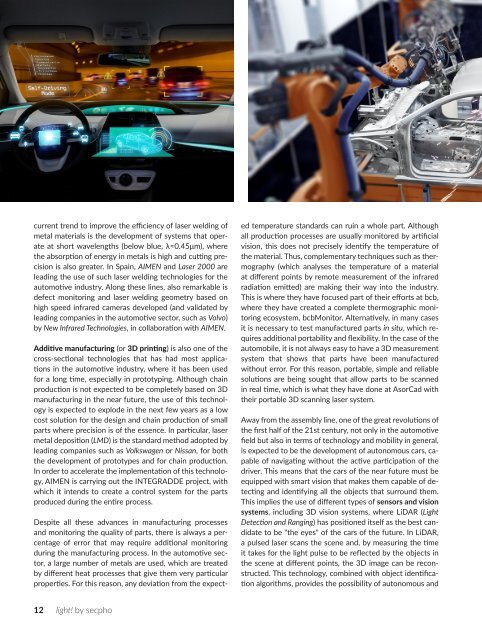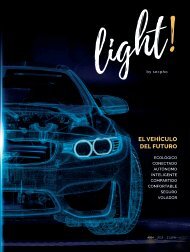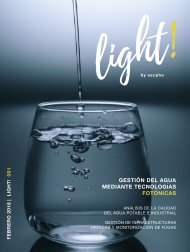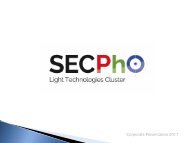light! 004 | The car of the future
Create successful ePaper yourself
Turn your PDF publications into a flip-book with our unique Google optimized e-Paper software.
current trend to improve <strong>the</strong> efficiency <strong>of</strong> laser welding <strong>of</strong><br />
metal materials is <strong>the</strong> development <strong>of</strong> systems that operate<br />
at short wavelengths (below blue, λ≈0.45μm), where<br />
<strong>the</strong> absorption <strong>of</strong> energy in metals is high and cutting precision<br />
is also greater. In Spain, AIMEN and Laser 2000 are<br />
leading <strong>the</strong> use <strong>of</strong> such laser welding technologies for <strong>the</strong><br />
automotive industry. Along <strong>the</strong>se lines, also remarkable is<br />
defect monitoring and laser welding geometry based on<br />
high speed infrared cameras developed (and validated by<br />
leading companies in <strong>the</strong> automotive sector, such as Volvo)<br />
by New Infrared Technologies, in collaboration with AIMEN.<br />
Additive manufacturing (or 3D printing) is also one <strong>of</strong> <strong>the</strong><br />
cross-sectional technologies that has had most applications<br />
in <strong>the</strong> automotive industry, where it has been used<br />
for a long time, especially in prototyping. Although chain<br />
production is not expected to be completely based on 3D<br />
manufacturing in <strong>the</strong> near <strong>future</strong>, <strong>the</strong> use <strong>of</strong> this technology<br />
is expected to explode in <strong>the</strong> next few years as a low<br />
cost solution for <strong>the</strong> design and chain production <strong>of</strong> small<br />
parts where precision is <strong>of</strong> <strong>the</strong> essence. In particular, laser<br />
metal deposition (LMD) is <strong>the</strong> standard method adopted by<br />
leading companies such as Volkswagen or Nissan, for both<br />
<strong>the</strong> development <strong>of</strong> prototypes and for chain production.<br />
In order to accelerate <strong>the</strong> implementation <strong>of</strong> this technology,<br />
AIMEN is <strong>car</strong>rying out <strong>the</strong> INTEGRADDE project, with<br />
which it intends to create a control system for <strong>the</strong> parts<br />
produced during <strong>the</strong> entire process.<br />
Despite all <strong>the</strong>se advances in manufacturing processes<br />
and monitoring <strong>the</strong> quality <strong>of</strong> parts, <strong>the</strong>re is always a percentage<br />
<strong>of</strong> error that may require additional monitoring<br />
during <strong>the</strong> manufacturing process. In <strong>the</strong> automotive sector,<br />
a large number <strong>of</strong> metals are used, which are treated<br />
by different heat processes that give <strong>the</strong>m very particular<br />
properties. For this reason, any deviation from <strong>the</strong> expected<br />
temperature standards can ruin a whole part. Although<br />
all production processes are usually monitored by artificial<br />
vision, this does not precisely identify <strong>the</strong> temperature <strong>of</strong><br />
<strong>the</strong> material. Thus, complementary techniques such as <strong>the</strong>rmography<br />
(which analyses <strong>the</strong> temperature <strong>of</strong> a material<br />
at different points by remote measurement <strong>of</strong> <strong>the</strong> infrared<br />
radiation emitted) are making <strong>the</strong>ir way into <strong>the</strong> industry.<br />
This is where <strong>the</strong>y have focused part <strong>of</strong> <strong>the</strong>ir efforts at bcb,<br />
where <strong>the</strong>y have created a complete <strong>the</strong>rmographic monitoring<br />
ecosystem, bcbMonitor. Alternatively, in many cases<br />
it is necessary to test manufactured parts in situ, which requires<br />
additional portability and flexibility. In <strong>the</strong> case <strong>of</strong> <strong>the</strong><br />
automobile, it is not always easy to have a 3D measurement<br />
system that shows that parts have been manufactured<br />
without error. For this reason, portable, simple and reliable<br />
solutions are being sought that allow parts to be scanned<br />
in real time, which is what <strong>the</strong>y have done at AsorCad with<br />
<strong>the</strong>ir portable 3D scanning laser system.<br />
Away from <strong>the</strong> assembly line, one <strong>of</strong> <strong>the</strong> great revolutions <strong>of</strong><br />
<strong>the</strong> first half <strong>of</strong> <strong>the</strong> 21st century, not only in <strong>the</strong> automotive<br />
field but also in terms <strong>of</strong> technology and mobility in general,<br />
is expected to be <strong>the</strong> development <strong>of</strong> autonomous <strong>car</strong>s, capable<br />
<strong>of</strong> navigating without <strong>the</strong> active participation <strong>of</strong> <strong>the</strong><br />
driver. This means that <strong>the</strong> <strong>car</strong>s <strong>of</strong> <strong>the</strong> near <strong>future</strong> must be<br />
equipped with smart vision that makes <strong>the</strong>m capable <strong>of</strong> detecting<br />
and identifying all <strong>the</strong> objects that surround <strong>the</strong>m.<br />
This implies <strong>the</strong> use <strong>of</strong> different types <strong>of</strong> sensors and vision<br />
systems, including 3D vision systems, where LiDAR (Light<br />
Detection and Ranging) has positioned itself as <strong>the</strong> best candidate<br />
to be "<strong>the</strong> eyes" <strong>of</strong> <strong>the</strong> <strong>car</strong>s <strong>of</strong> <strong>the</strong> <strong>future</strong>. In LiDAR,<br />
a pulsed laser scans <strong>the</strong> scene and, by measuring <strong>the</strong> time<br />
it takes for <strong>the</strong> <strong>light</strong> pulse to be reflected by <strong>the</strong> objects in<br />
<strong>the</strong> scene at different points, <strong>the</strong> 3D image can be reconstructed.<br />
This technology, combined with object identification<br />
algorithms, provides <strong>the</strong> possibility <strong>of</strong> autonomous and<br />
12 <strong>light</strong>! by secpho












